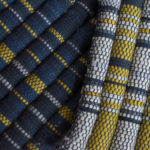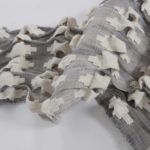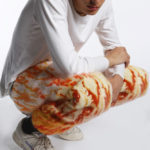 The following Weave Designers all graduated in 2017.
The following Weave Designers all graduated in 2017.
This is a showcase of their final collections.
(Image above) Inspired by work wear and protective wear, I explored the ways in which specialist materials have been used to cover bodies that are at risk, for example soldiers and firefighters.
My designs use fabrics that are typically found in protective wear, such as padding, high visibility fabrics, neon, metals and rubber and the inclusion of text. Function//Fashion mixes new and old fibers and materials together to create hybrid pieces that reflect and acknowledge the history of protective wear.
As my research progressed I became interested in subverting ideas of clothing that is meant to protect the body and began to create faux protective wear in which style would triumph over substance. Workwear and uniforms are a constantly recurring trope of much recent fashion design, and I wanted to play with the idea of subverting and commenting on high fashion, which is aimed at and designed for elite consumers, by overlaying themes and fabrics from protective and work wear clothing onto ‘fashion’ pieces.
Perhaps thinking about recent world events and the possibility of this continuing in the future: if life in developed, capitalist countries becomes more dangerous, even for the elite, protective clothes will become not the sign of the worker, but the sign of the elite, of those that can afford ‘protection’.
email: ialbagwell@gmail.com
Tasnim Begum: Metro-Structures
 Metro-Structures is a collection influenced by the issue of overcrowding, claustrophobia, and the invasion of personal space, that one faces whilst travelling on the tube. The physical infrastructures of various train stations were used as inspiration for shapes, form and colour to create high-end luxury 3-dimensional woven designs, that cocoon the wearer – enveloping them with a sense of security and protection.
Metro-Structures is a collection influenced by the issue of overcrowding, claustrophobia, and the invasion of personal space, that one faces whilst travelling on the tube. The physical infrastructures of various train stations were used as inspiration for shapes, form and colour to create high-end luxury 3-dimensional woven designs, that cocoon the wearer – enveloping them with a sense of security and protection.
Inspired by the arts, history and materials, I am particularly intrigued by the heritage of textiles and how to translate this in modern culture. In my work I explore the relationship between textiles and witchcraft and the idea of weaving as a form of code. Contact:Â poppyfullerabbott@hotmail.co.uk
Katie Jenner:
Exploring scale, warping and resizing designs inspired by architectural concepts, utilising tubular and projecting profiles. Transforming these findings into sensory engagement materials by creating three dimensions to fabric by twisting, knotting, creating loops and weaving to add depth and tactility to cloth, suitable for my interior collection.
I am passionate about material and fascinated by the way humans can react to the feel and texture of the fabric. Inspiration has been a continuous process throughout, always seeking new and exciting tubular, padded, projecting surfaces and textures. Photography also is one my main source of visual research, using Photoshop to explore and develop designs further to transforming them into hand woven samples, jacquards and digital prints.
I explore a variety of different ways of how I can manipulate and create three dimensions with a combination of techniques. I research into different materials and how I can transform and manipulate quite mundane objects and their properties into unique textile fabrics. Both manual and digital processes are a key focus and aim throughout my projects always aspiring to create larger scale, off the loom pieces.
Rebecca Mary Ann Jones
My project Intertwine is inspired by contrasting expressive marks and structure to represent the interlinking narrative between architecture and nature, products and people. By exploring the relationship between the visual and tactile qualities of fabric construction, I seek to ensure longevity within my woven textile designs.
The tactility of the cloth is central to the Intertwine concept evoking the cloths expression and therefore forming an emotional bond to the individual through the feel of the fabric. Across my furnishing and soft furnishing collections I have created innovative interior fabrics, which evoked comfort and visually connected with the consumer by injecting colour and interest into people’s homes. As a textile designer, I understand the importance of the texture of materials and how this affects performance and engagement with the consumer.
This is a method of connecting with the consumer on a deep level, enabling the growth of emotional durability with a product through the feeling of comfort in fashion and interiors. The wool fibre has been central to achieving this quality in my collections, with its soft feel, tactility and warmth when next to your skin. I have designed tags to translate the sustainable message for my blanket collection, (see in gallery below) made up of key statements covering wools sustainable message, longevity of design and connection with the customer.
I have mainly concentrated on using wool fibres as they not only have a soft feel but also have the opportunity to be recycled or reused for a second life due to it being a high quality fibre, which is durable. The fibre is natural occurring as a by-product with little environmental impact, due to its natural anti-bacterial qualities mean the products will keep fresh for longer making them low impact in the laundry phase. I am of the view that the tags enable an effective method of communicating the assets of the wool fibre in my textile samples.
Helen Milne: Archiving The Anthropocene
The current geological age, the ‘Anthropocene’ is defined by collective polluting human activity. We are the single greatest accelerator of climate change ever.
This project is a protest: a personally driven, site-specific, material exploration of coastal erosion, plastic pollution and air pollution in the UK. Through documentation of significant ‘visual metaphors’ relating to climate change, Helen has developed a visual and material language
using yarns polluted with toxic van dirt, polyester (notoriously bad for micro-plastic pollution) and a variety of rusted yarns and processed metals. The jacquard and hand-woven collection takes the form of flags, for their ability to convey a warning message. There have long been protests and calls for action about the climate – and we need to continue to do so, particularly in times of political uncertainty.
Contact: hellymilne@gmail.com
This collection, is inspired by mid century abstract sculpture. Specifically the aspects of using the human form to inspire flowing shapes that have a sense of movement, but are in fact fixed objects. My aim for this collection was to emulate and abstract the human body through motion, via the exploration of dancers’ movement and composition. My textiles are static and sculptural in form, yet translate the fluidity and evoke the animation and gestures of human form.
Toyi See Toh: Off Grid
Off Grid is inspired by the invasion of plants in the abandoned places over a long period of time. The aim of the project was to create a collection of woven fabrics for high-end menswear that gives the illusion of growth but they are artificial in their context. I have explored the contrast between the rigid manmade architectural structures and organic flow of the over growing textures from plants. I am interested in how spaces have created a chaotic pattern, yet maintained the structured outline over the years by overlaying and growing through gaps in the natural landscape.
Insta:@chewytoyiii
Email:toyiseetoh@hotmail.co.uk
Anna-Maie Southern: The Mind’s Eye

‘The Mind’s Eye’ is a menswear collection, which aims to highlight issues of mental health and wellbeing among young men. These woven fabrics incorporate imagery and text to help young men communicate what they and many others are thinking. The collection allows the wearer to actively wear their ‘mind’ on their sleeve thereby reducing social isolation and stigma surrounding mental health difficulties.
‘The Mind’s Eye’ collection of wellbeing fabrics are inspired by art therapy techniques and surrealism, a movement which visually translates the subconscious.Â
Natasha Tallon:‘Is ornament really a crime?’
 Natasha was initially inspired by the famous essay ‘Ornament and Crime’ by Austrian modernist architect Adolf Loos.
Natasha was initially inspired by the famous essay ‘Ornament and Crime’ by Austrian modernist architect Adolf Loos.
After reading the essay along with other manifestos by various modernist theorists, Natasha noticed a recurring theme; the emphasis of functionality in modern living.
Natasha has looked to ‘solve’ a design confliction by asking ‘Is ornament really a crime?’ resulting in a textile collection that challenges weight, density and materiality. The materials created hold both functional and ornamental qualities and with more research could potentially be developed into a fully functional flat pack furniture concept.
Natasha has become particularly intrigued by the functionality of materials in her final year at Central Saint Martins and is a keen advocate of minimal consumer attitudes. In the future she hopes to investigate alternative applications for textile materials and expand on her passions for materials and functionality within design.
With thanks to all the Weave Designers above for their text and images. Copyright the designers above. If other 2017 graduates wish to have their work featured then please send text in a word doc and x3 images ( at least one landscape through www.wetransfer) to info@theweaveshed.org.



































Leave a Reply